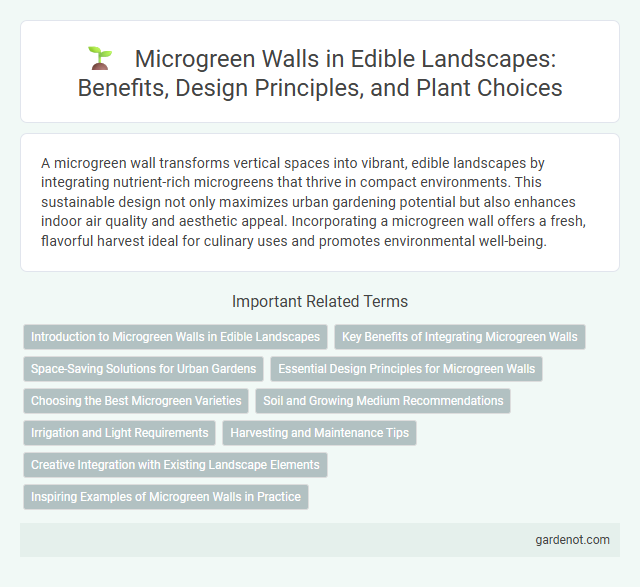A microgreen wall transforms vertical spaces into vibrant, edible landscapes by integrating nutrient-rich microgreens that thrive in compact environments. This sustainable design not only maximizes urban gardening potential but also enhances indoor air quality and aesthetic appeal. Incorporating a microgreen wall offers a fresh, flavorful harvest ideal for culinary uses and promotes environmental well-being.
Introduction to Microgreen Walls in Edible Landscapes
Microgreen walls integrate vibrant, nutrient-dense microgreens into vertical garden systems, transforming edible landscapes into efficient, space-saving food sources. These living walls harness controlled environments to optimize growth, enhancing urban agriculture by providing fresh, sustainable produce year-round. Incorporating microgreen walls improves air quality and aesthetic appeal while promoting health through accessible, homegrown superfoods.
Key Benefits of Integrating Microgreen Walls
Microgreen walls enhance indoor air quality by naturally filtering pollutants and increasing oxygen levels, promoting a healthier living environment. They maximize urban space utilization by providing a vertical, edible garden that supports sustainable food production within limited areas. Integrating microgreen walls also boosts aesthetic appeal and mental well-being through vibrant greenery and fresh, nutrient-rich microgreens accessible for culinary use.
Space-Saving Solutions for Urban Gardens
Microgreen walls offer a highly efficient space-saving solution for urban gardens by utilizing vertical surfaces to grow nutrient-dense microgreens. These installations maximize limited urban areas, promoting sustainable food production while enhancing aesthetic appeal. Integrating hydroponic or soil-based microgreen walls supports year-round harvests, making urban gardening more accessible and productive.
Essential Design Principles for Microgreen Walls
Microgreen walls require precise light optimization, ensuring 12-16 hours of full-spectrum LED exposure to support photosynthesis and nutrient density. Structural stability is critical, using modular panels with integrated irrigation systems that promote consistent moisture and prevent waterlogging. Selecting diverse microgreen species enhances both aesthetic appeal and nutritional variety, maximizing the edible landscape's functional and visual impact.
Choosing the Best Microgreen Varieties
Selecting the best microgreen varieties for an edible landscape microgreen wall involves prioritizing fast-growing, nutrient-dense plants such as sunflower, pea shoots, radish, and basil. These varieties offer vibrant colors, diverse flavors, and a high yield within a short growth cycle of 7 to 14 days, optimizing both aesthetic appeal and nutritional value. Ensuring proper light exposure, consistent moisture, and quality soil or growing medium enhances the growth and health of these microgreens on the vertical surface.
Soil and Growing Medium Recommendations
Microgreen walls thrive best in well-draining, nutrient-rich soil blends that retain moisture while preventing waterlogging, typically composed of organic compost, coconut coir, and perlite. A balanced pH between 6.0 and 7.0 ensures optimal nutrient absorption, supporting vigorous microgreen growth. Incorporating lightweight, sterile growing mediums like peat moss or vermiculite enhances aeration, reduces disease risk, and promotes healthy root development in vertical edible landscapes.
Irrigation and Light Requirements
Microgreen walls demand consistent, low-volume irrigation systems such as drip or mist to maintain optimal moisture without overwatering. Adequate lighting requires full-spectrum LED grow lights providing 12-16 hours daily at an intensity of 200-400 umol/m2/s to promote vigorous growth and nutrient density. Proper irrigation and light conditions enhance microgreen yield, flavor, and nutritional content in edible landscape installations.
Harvesting and Maintenance Tips
Harvest microgreens on your edible landscape wall when leaves reach 1-2 inches to ensure peak flavor and nutrition. Maintain consistent moisture with a spray bottle to avoid overwatering and mold growth, while providing 12-16 hours of indirect sunlight for optimal photosynthesis. Regularly trim to promote regrowth and prevent overcrowding, enhancing continuous harvests from your microgreen wall.
Creative Integration with Existing Landscape Elements
Microgreen walls offer a dynamic way to creatively integrate edible landscapes within existing garden structures, such as fences, pergolas, and vertical trellises, maximizing limited space for urban gardening. Incorporating microgreen panels into stone or wooden walls enhances both aesthetics and functionality by seamlessly blending nutrition-rich greens with natural material textures. Designing with diverse crop varieties in these vertical installations promotes biodiversity while supporting sustainable food production in compact outdoor environments.
Inspiring Examples of Microgreen Walls in Practice
Microgreen walls transform urban spaces into vibrant, sustainable food sources, showcasing versatility and aesthetic appeal in edible landscapes. Examples such as vertically integrated farms in New York and community gardens in Singapore highlight efficient harvesting and nutrient density of microgreens grown on walls. These installations demonstrate innovative use of limited space to enhance food security and promote environmental wellness in metropolitan areas.
Microgreen wall Infographic

 gardenot.com
gardenot.com